The Buddhist Councils and Summits: Preserving and Propagating the Dhamma
First Buddhist Council (486 BC)
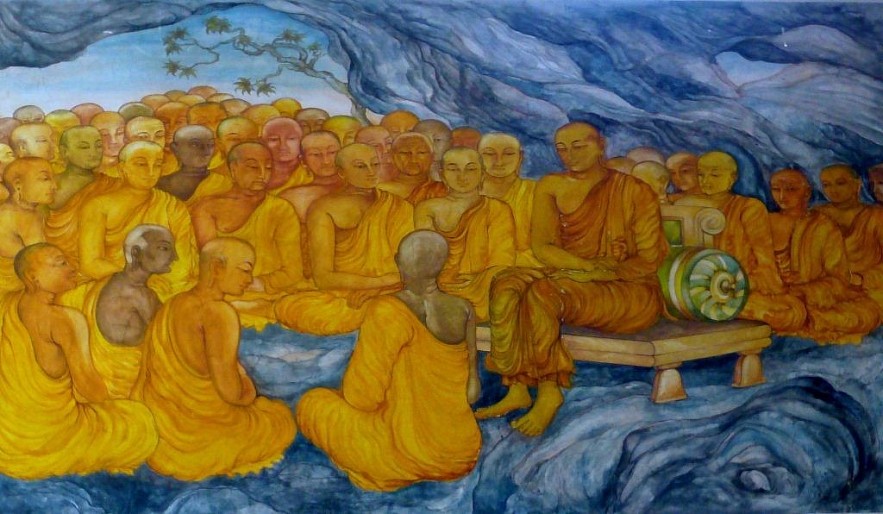 |
| Photograph of murals in the Nava Jetavana temple, Nava Jetavana Park, Shravasti, Uttar Pradesh |
The inaugural Buddhist Council took place in Rajagriha soon after the Buddha’s passing. Led by Venerable Mahakassapa, 500 arahants gathered to recite and preserve the Buddha’s teachings under the patronage of the king Ajātasattu. This council laid the foundation for the Tripitaka, categorizing the scriptures into three divisions: Vinaya Pitaka, Sutta Pitaka, and Abhidhamma Pitaka. The teachings were orally transmitted to ensure their authenticity and subsequently passed down through generations.
Second Buddhist Council (383 BC)
The Second Buddhist Council convened in Vaishali, addressing disagreements within the monastic community. It was initiated by King Kalasoka while it was presided by Sabakami to resolve disputes concerning monastic rules. The council witnessed a schism between the orthodox and liberal factions, leading to the formation of the Mahasanghika sect. Though it resulted in a division, the council highlighted the importance of upholding the Buddha’s original teachings.
Third Buddhist Council (250 BC)
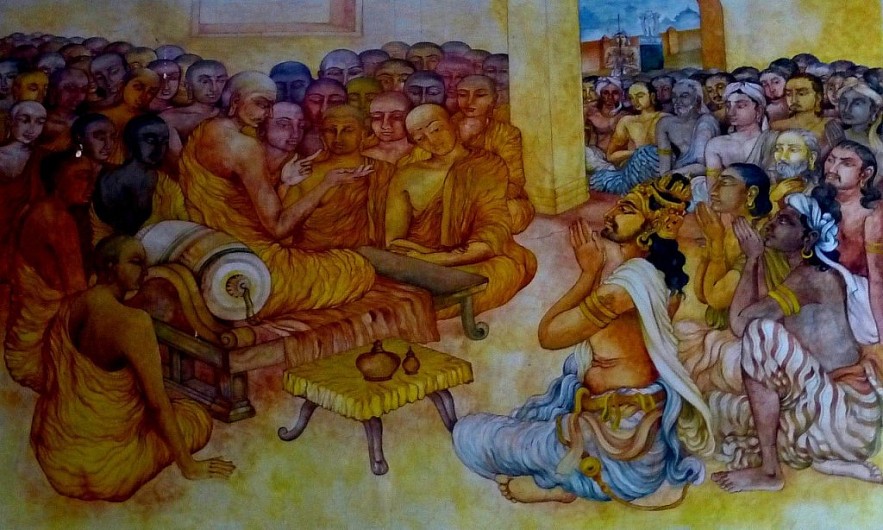 |
| Ashoka and Moggaliputta-Tissa at the Third Council, at the Nava Jetavana, Shravasti, Uttar Pradesh |
Emperor Ashoka organized the Third Buddhist Council in Pataliputra to purify and clarify the Dhamma. Under the guidance of Moggaliputta Tissa, 1,000 arahants participated in the council. It aimed to combat distortions and false interpretations that had emerged. According to tradition, the Third Buddhist Council was called in order to purge the Sangha of corruption, including enemies who had infiltrated the Sangha under the guise of supporters and monks who held heretical beliefs, specifically those of the Mahasangika Sect of Buddhism (according to Ashoka’s perception). The council advised the emperor Ashoka to review the Pli Canon and remove 60,000 Mahasangika spies.
The compilation of the Abhidhamma Pitaka during this council deepened the understanding of Buddhist philosophy. Ashoka’s efforts to propagate Buddhism beyond India were also reinforced through the council.
Fourth Buddhist Council (Sarvastivada tradition, 1 AD)
The Kushan ruler Kanishka called the Fourth Buddhist Council of the Sarvastivada tradition in the Kundalvana vihara in Kashmir. Theravadins do not consider the Fourth Council of Kashmir to be canonical; yet, accounts of this council may be found in texts that belonged to the Mahayana school. The Sarvastivadin Abhidharma writings served as the foundation for some of the Mahayana tradition’s literature.
500 monks led by Vasumitra were convened by Kanishka during the council to prepare in-depth comments on the Sarvastivadin Abhidharma, however it’s conceivable that some editing was done to the already-existing canon. The enormous commentary known as the Mahavibhasa(“Great Exegesis”), a comprehensive compilation and reference work on a section of the Sarvastivadin Abhidharma, is what came of it.
Fourth Buddhist Council (Theravada Buddhism, 29–17 BCE)
King Vattagamani Abhaya convened the Fourth Buddhist Council in Anuradhapura, Sri Lanka. Its primary objective was to preserve the Tripitaka and purify the Sangha. Scholars and monks worked diligently to compile commentaries and sub-commentaries, providing further insight into the Buddhist scriptures. This council played a pivotal role in ensuring the accuracy of the teachings amidst changing times.
The council was established in reaction to a year in which Sri Lanka’s harvests were very meager, leading to the starving deaths of several Buddhist monks. The remaining monks understood the risk of not recording the Pali Canon because it was at the time oral literature that was kept in multiple recensions by dhammabhanakas (dharma reciters).
Following the Council, the finished Canon was sent to nations like Burma, Thailand, Cambodia, and Laos on palm-leaf manuscripts.
Fifth Buddhist Council (Theravada Buddhism, 1871 CE)
The Fifth Buddhist Council, held in Mandalay, Burma, under King Mindon’s patronage, aimed to preserve the Tripitaka in written form. The Dhamma was inscribed on marble slabs and palm-leaf manuscripts for wider distribution. The council’s emphasis on accurate transcription solidified the accessibility and longevity of the Buddhist scriptures.
Recent Summits on Buddhism
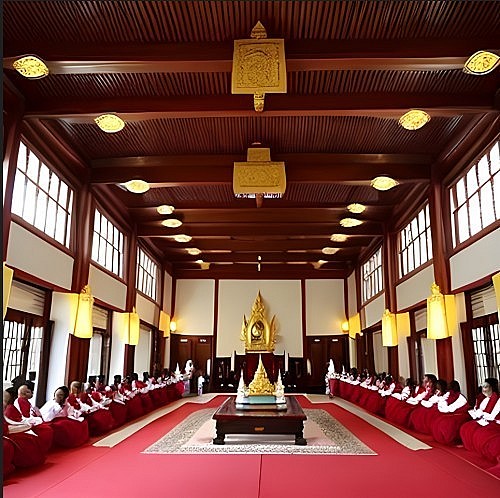 |
| Representation of the recent Buddhist Summits |
Summit in Myanmar
The council, also known as the “Sixth Buddhist Synod,” took place from 1954 to 1956 in the city of Yangon (formerly Rangoon). Its primary purpose was to recite and reaffirm the entire Tipitaka (the Buddhist scriptures).
The council was initiated by the government of Myanmar, led by Prime Minister U Nu. The objective was to preserve and promote the authentic teachings of Buddhism and ensure their accuracy in the face of potential errors or inconsistencies that may have arisen over time.
During this summit, a large assembly of monks and scholars from various Theravada Buddhist countries gathered to meticulously recite and examine the scriptures. The recitation process aimed to verify and ensure the correct pronunciation and intonation of the Pali texts. Monks chanted and recited the entire Tipitaka, which includes the Vinaya Pitaka (rules for monastic discipline), Sutta Pitaka (discourses of the Buddha), and Abhidhamma Pitaka (philosophical analysis).
World Buddhist Summit (1998, 2002, 2008)
The World Buddhist Summit is an international gathering that takes place periodically to promote inter-Buddhist dialogue and understanding. It aims to foster unity among Buddhist traditions and address common challenges faced by Buddhists globally.
International Buddhist Conclave (2012–2020 Biennially)
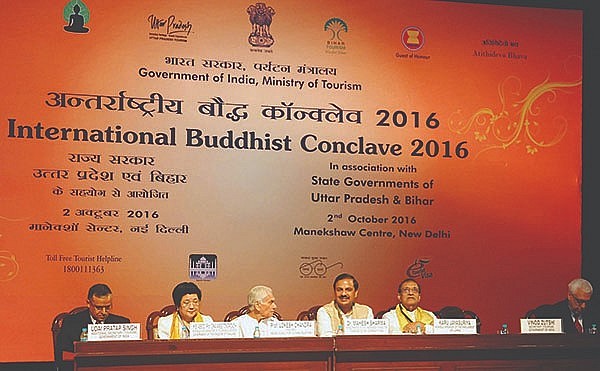 |
| International Buddhist Conclave, 2016 |
The International Buddhist Conclave is an event organized by the Government of India in collaboration with Buddhist organizations. It brings together Buddhist leaders, scholars, and enthusiasts from various countries to celebrate and explore the Buddhist heritage of India.
World Buddhist Forum (Since 2006 Triennially)
The World Buddhist Forum is an influential international conference initiated by the Chinese Buddhist community. It aims to promote Buddhist teachings, cultural exchange, and social harmony. The forum addresses topics such as ethics, education, and environmental sustainability from a Buddhist perspective.
China being an atheist country has been steadily building its own home-grown narrative on Buddhism, which hinges on a very controlled and regulated practice under the close supervision of the government.
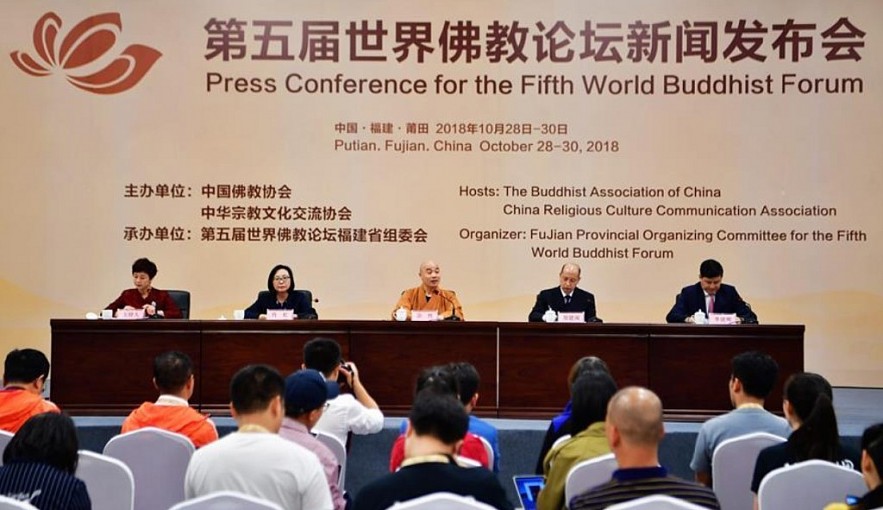 |
| First Global Buddhist Summit 2023 The two-day Global Buddhist Summit 2023 concluded successfully in New Delhi with the adoption of the New Delhi Declaration. Hosted by the International Buddhist Confederation in collaboration with the Indian Ministry of Culture, the event saw participation of delegates from nearly 30 countries, including major Buddhist countries like Myanmar, Thailand, Vietnam, Sri Lanka, and Mongolia. Those in attendance included monks, scholars, nuns and heads of Buddhist organisations. The presence of His Holiness the Dalai Lama at the summit added immense significance to the event. He delivered keynote speeches and engaged in discussions on various topics related to Buddhism and its relevance in the modern world. |
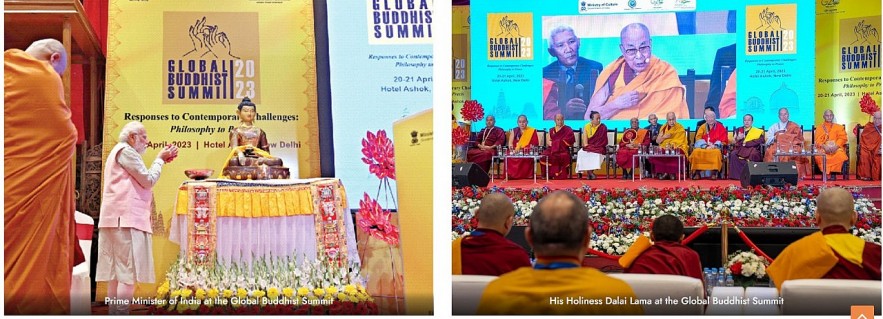 |
The aim behind the “Global Buddhist Summit” was to internalise universal values, find ways to work together in a harmonious manner and offer a sustainable model for the future of the world. The summit was inaugurated by Prime Minister Narendra Modi and concluded on a positive note that peace is the foundation for human happiness and well-being. The theme of the two-day “Global Buddhist Summit” was “Responses to Contemporary Challenges: Philosophy to Praxis”.
“The path of Buddha is the path of the future, the path of sustainability. If the world had followed the teachings of Buddha, then even a crisis like climate change would not have come in front of us. This crisis occurred because, in the last century, some countries did not think about others, about future generations,”
Mr. Narendra Modi, Hon’ble Prime Minister of India proclaimed in the first Global Buddhist Summit
Conclusion
In conclusion, the Buddhist councils held in the past played a crucial role in preserving and disseminating the teachings of the Buddha, ensuring the integrity of the Buddhist scriptures, and fostering unity among the monastic community. These councils were pivotal in shaping the development and growth of Buddhism, as they provided a platform for clarifying doctrinal disputes, standardizing practices, and promoting harmony within the sangha.
In the present day, the global Buddhist summits continue to carry forward the spirit of unity, collaboration, and dialogue among Buddhist communities worldwide. These summits provide a platform for Buddhist leaders, scholars, and practitioners to come together, exchange ideas, address contemporary challenges, and explore ways to apply Buddhist principles in solving modern-day problems.
